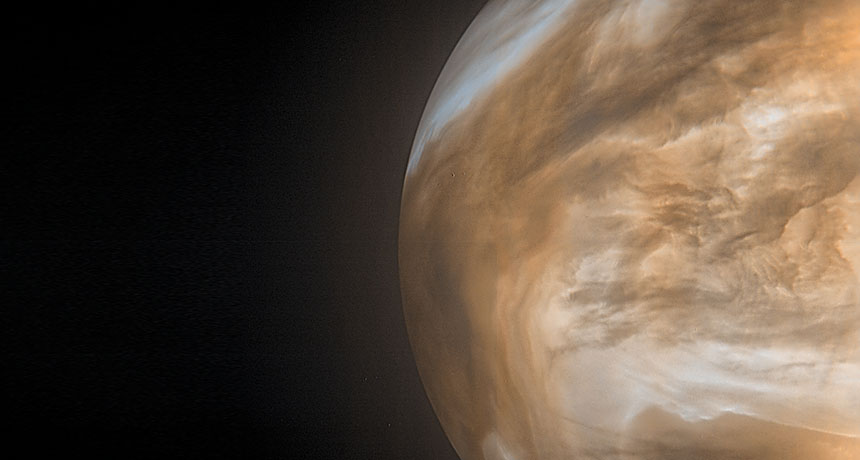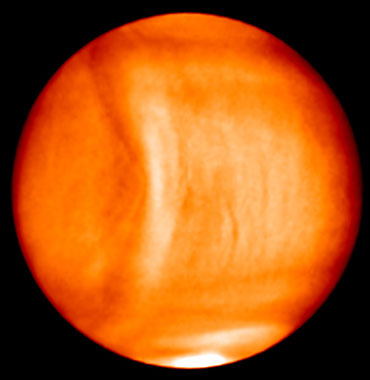Thick atmosphere boosts how fast Venus spins
Planet’s rotational speed can change based on how air flows over mountain tops

With help from its thick atmosphere, the speed at which Venus spins changes. This planet close-up was taken by the Japanese space agency’s Akatsuki spacecraft.
Damia Bouic, DARTS, ISAS, JAXA
Share this:
- Share via email (Opens in new window) Email
- Click to share on Facebook (Opens in new window) Facebook
- Click to share on X (Opens in new window) X
- Click to share on Pinterest (Opens in new window) Pinterest
- Click to share on Reddit (Opens in new window) Reddit
- Share to Google Classroom (Opens in new window) Google Classroom
- Click to print (Opens in new window) Print
Time gets tricky on Venus. The planet has extremely thick air, which flows much more rapidly than the rate at which the solid planet spins. As that thick atmosphere pushes against the planet’s mountains, it can change how quickly Venus spins, scientists now report.
Researchers used a computer to simulate the movements of that thick atmosphere. It whips around at 100 meters per second (around 224 miles per hour). Those winds exert enough push against mountains on one side of the planet — and suction on the other side — to alter the speed of the planet’s rotation. The thick atmosphere increases the rotation rate by up to about two minutes each day. Each Venus day, that is. And each day on this planet is 243 times longer than one on Earth.
Two minutes is not much in a rotation that lasts almost 350,000 Earth minutes. Venus’ atmosphere, by contrast, rotates about once every four Earth days (5,760 Earth minutes).
There also must be some other force slowing the planet’s spin back down. If not it would continue to just spin faster and faster. What might that other force be? Researchers suspect it could be the sun’s gravitational influence.
The researchers reported their calculation in the July issue of Nature Geoscience.
Then there’s that mighty wave
Precise measurements of the rotational period (day length) on Venus have varied by up to seven minutes. The push and pull of the air over the planet’s mountains could help explain this mismatch.

Thomas Navarro and his colleagues wanted to better understand the differences in the planet’s spin. Navarro is a planetary scientist at the University of California, Los Angeles. He was part of a team that developed the computer model to study the thick Venusian atmosphere and how it affects the planet’s spin. Their results are the first to explain a bizarre wave found atop the planet’s clouds. That wave is 10,000 kilometers (6,200 miles) long, extending from pole to pole.
The Japanese space agency’s Akatsuki spacecraft first spotted that wave in 2015. Similar waves ripple through Earth’s atmosphere when air flows over a mountain. But those Earth waves normally dissipate quickly. Opposing winds break them up. Not so on Venus. Its atmosphere rotates far faster around the planet — and in only one direction. So once formed, such waves can persist for a long time.
“This work is very interesting,” says Tetsuya Fukuhara. He is a planetary scientist at Rikkyo University in Tokyo, Japan. He also is among the researchers who discovered those waves in the atmosphere of Venus. The new work, he says, helps explain where the wave comes from. It also addresses how surface features on Venus affect its atmosphere. That “is the most important issue in the Venus atmospheric science,” he says.
Scientists hope to get even more detailed measurements of Venus’ rotation. That could help them better understand how the atmosphere influences it. Those measurements could be taken with a future lander. And, they could eventually help reveal details of the planet’s interior, such as the size of its core.
“Venus is the closest thing to Earth that we know of,” Navarro says. And yet, it’s hot, thick, toxic atmosphere makes it utterly alien. “We’d like to know what’s inside.”







